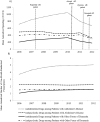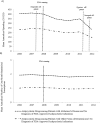Pharmaceutical Use and Spending Trend in Medicare Beneficiaries With Dementia, From 2006 to 2012
- PMID: 28474001
- PMCID: PMC5407657
- DOI: 10.1177/2333721417704946
Pharmaceutical Use and Spending Trend in Medicare Beneficiaries With Dementia, From 2006 to 2012
Abstract
Objectives: The aim of the study was to examine the trend in incidence and prevalence of dementia, use and spending of antidementia and antipsychotic drugs among dementia patients. Methods: Using 2006-2012 Medicare claims data, we identified individuals with diagnosis of dementia and collected their pharmacy claims in 2006-2012. We built regression models to test the trend in number of prescriptions and spending on antidementia, antipsychotic, and other drugs. Results: The prevalence of dementia did not change during our study period. Spending on antidementia and antipsychotic drugs creased to increase in 2011, following the patent expiration of Aricept, Zyprexa, and Seroquel; and total pharmaceutical spending did not change in 2006-2012. Use of antidementia drugs increased during our study period; however, the off-label use of antipsychotic drugs did not decrease. Discussion: Pharmaceutical spending associated with dementia may not be as concerning for Medicare as previously thought; nevertheless, policies that discourage the nonevidence-based off-label use of drugs are warranted.
Keywords: dementia; health services; medications; policy.
Conflict of interest statement
Declaration of Conflicting Interests: The authors declared no potential conflicts of interest with respect to the research, authorship, and/or publication of this article.
Figures



Similar articles
-
Impact of deprivation, dementia prevalence and regional demography on prescribing of antidementia drugs in England: A time trend analysis.Br J Clin Pharmacol. 2021 Oct;87(10):3747-3755. doi: 10.1111/bcp.14782. Epub 2021 Mar 10. Br J Clin Pharmacol. 2021. PMID: 33599972
-
Factors associated with psychotropic prescriptions, psychiatric hospitalization, and spending among Medicare beneficiaries under 65.Disabil Health J. 2015 Jul;8(3):424-33. doi: 10.1016/j.dhjo.2015.03.005. Epub 2015 Mar 14. Disabil Health J. 2015. PMID: 25890881
-
Effect of Medicare Part D on Ethnoracial Disparities in Antidementia Medication Use.J Am Geriatr Soc. 2018 Sep;66(9):1760-1767. doi: 10.1111/jgs.15494. Epub 2018 Aug 10. J Am Geriatr Soc. 2018. PMID: 30095169
-
Patterns of Dementia Treatment and Frank Prescribing Errors in Older Adults With Parkinson Disease.JAMA Neurol. 2019 Jan 1;76(1):41-49. doi: 10.1001/jamaneurol.2018.2820. JAMA Neurol. 2019. PMID: 30285047 Free PMC article.
-
Treatment of dementia in community-dwelling and institutionalized medicare beneficiaries.J Am Geriatr Soc. 2007 Oct;55(10):1508-16. doi: 10.1111/j.1532-5415.2007.01387.x. Epub 2007 Aug 28. J Am Geriatr Soc. 2007. PMID: 17727648
Cited by
-
Impact of the COVID-19 pandemic on use of anti-dementia medications in 34 European and North American countries.Alzheimers Dement (N Y). 2021 Oct 14;7(1):e12206. doi: 10.1002/trc2.12206. eCollection 2021. Alzheimers Dement (N Y). 2021. PMID: 34692984 Free PMC article.
-
Risk Factors for Cardiovascular Events in Patients on Antidementia Medications.Am J Alzheimers Dis Other Demen. 2020 Jan-Dec;35:1533317520922380. doi: 10.1177/1533317520922380. Am J Alzheimers Dis Other Demen. 2020. PMID: 32383387 Free PMC article.
References
-
- Bharmal M. F., Dedhiya S., Craig B. A., Weiner M., Rosenman M., Sands L. P., . . .Thomas J. (2012). Incremental dementia-related expenditures in a Medicaid population. American Journal of Geriatric Psychiatry, 20, 73-83. - PubMed
-
- Brookmeyer R., Johnson E., Ziegler-Graham K., Arrighi H. M. (2007). Forecasting the global burden of Alzheimer’s disease. Alzheimer’s & Dementia, 3, 186-191. - PubMed
-
- Centers for Medicare & Medicaid Services Chronic Conditions Data Warehouse. (2013). Medicare beneficiary prevalence for chronic conditions for 2002 through 2011. Retrieved from https://www.ccwdata.org/web/guest/medicare-charts/medicare-chronic-condi...
-
- Centers for Medicare & Medicaid Services Chronic Conditions Data Warehouse. (2014). 27 chronic condition algorithm. Retrieved from https://www.ccwdata.org/web/guest/condition-categories
LinkOut - more resources
Full Text Sources
Other Literature Sources

